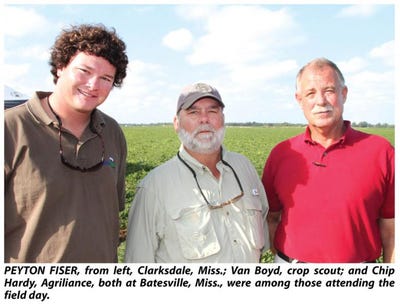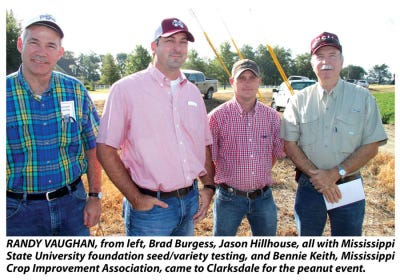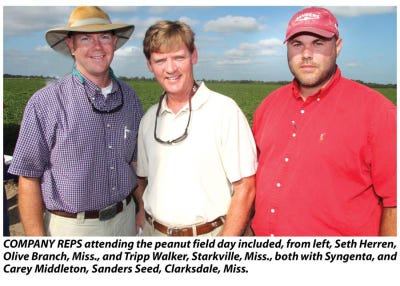
“There has been a lot of enthusiasm for peanuts — not just because of the potential for attractive returns, but for growers with suitable soils the crop an opportunity for diversification and rotation benefits,” Don Respess, Mississippi State University Extension director for Coahoma County, Miss., said at the North Mississippi Peanut Field Day on the farm of John and Mark Agostinelli at Clarksdale.

For many north Mississippi farmers who are growing peanuts for the first time this year, it has been a learning experience.
“There has been a lot of enthusiasm for the crop — not just because of the potential for attractive returns, but for growers with suitable soils peanuts offer an opportunity for diversification and rotation benefits,” said Don Respess, Mississippi State University Extension director for Coahoma County, Miss.
Last year, he said at the North Mississippi Peanut Field Day on the farm of John and Mark Agostinelli at Clarksdale, “As best we can determine, there were only about 14,500 acres of peanuts in north Mississippi. This year, there are 30,000 to 35,000 acres, and statewide more than 50,000 acres.
“The Clint Williams Company is making substantial investments in facilities at Clarksdale and Greenwood, said to be the largest peanut storage facilities in the U.S., and Birdsong Peanuts has large operations in east Mississippi and in Arkansas — so it looks like this is a crop that’s here to stay,” Respess says.
At the field day event, growers were briefed on weed, disease, insect, and harvest issues that have occurred this season, along with tips for next season.
“Many of the weed issues that growers face with peanuts they’ve already have experience with in other crops,” said
Tom Eubank, assistant research/Extension professor of weed science at the Delta Research and Extension Center, Stoneville, Miss. “A lot of the products for use in peanuts are the same as for soybeans.”
Growers who have ALS-resistant pigweed need to be aware of the importance of rotating crops and chemistries, he says.
“Starting with clean ground is imperative for peanuts because of the long interval from planting to canopy. Early season weed management is critical — if you don’t start clean, you could be looking at a mess the rest of the season.”
Weed wipers can be effective on escaped weeds, Eubank says, because peanut plant height remains fairly low all season.
2,4-DB is a material that can be very effective in peanut weed control, especially in sequential applications, he says.
Jeff Gore, assistant research professor of entomology at the Delta Research and Extension Center, said peanut research has been under way at the station for the past five years, “and for the past year we’ve had an extensive insect management program.
“Probably 95 percent of the questions we’ve had this year have been regarding above-ground insects; there was quite a bit of concern about thrips and tomato spotted wilt virus disease (TSWV) early in the season.
“With the varieties we have now, growers don’t have to worry as much about TWSV as they did 20 years ago,” Gore says. “The newer varieties have more tolerance to this disease.”
Thrips management options at planting include granular insecticides such as Thimet, he says. “Where these can be used, they are effective in getting plants off to a better start.
“In-furrow sprays are also a good option for thrips control, but they can increase the incidence of TWSV. For a short time after these materials are applied, the thrips go into a feeding frenzy, they move from plant to plant faster, and this can spread TWSV more rapidly.”
Another option for thrips control, he says, is Cruiser treated seed. “Cruiser provides good control of thrips, but the occurrence of TSWV can be higher where it is used for the same reason mentioned with in-furrow sprays.”
Early burndown important
Gore said he didn’t recall getting a single question this year about soil insects, “which are more important in terms of potential yield reduction.
“It’s important to make your burndown applications early in order to get rid of weeds that insects such as wireworms feed on; if the soil insect complex is not controlled, they can cause some pretty severe yield losses.”
Thimet, Temik, or Lorsban applied at planting are the best options for controlling these pests, he says, but some control is also seen with Admire Pro as an in-furrow spray or Cruiser as a seed treatment.
The lesser cornstalk borer can be a significant pest of peanuts, Gore says. If they are already in the field, one option for control is Lorsban 15G applied on a band or broadcast.
“Probably 90 percent of the calls we’ve received this year have been about foliage feeding worms: corn earworms, loopers, fall armyworms, cutworms, etc.
“Peanuts can withstand a lot of foliage loss, particularly early in the season, less so late season. Cutworms are a concern because they not only will feed on foliage, but will cut pegs and branches, which can result in direct yield losses.
“For the most part, pyrethroids do not provide good control of most of the caterpillars in peanuts. There are a number of good worm-specific products for control, including Belt, Dimilin, Tracer, Steward and others.
“These products are also less likely to flare spider mites, for which there aren’t a lot of control options. Spider mites can be absolutely devastating in peanuts. The only option for control is Comite II, and only two applications can be made during the season. The scary thing is that Comite II has not performed well in other crops for a few years now.”
Three-cornered alfalfa hoppers can also occur in peanuts, he says, but yield loss is “fairly minor compared to flared spider mites. Growers should consider holding off on applications until they start seeing a significant amount of girdling on pegs.
“Pyrethroids provide very good control of this pest. If an application does need to be made, the best option is to use a bifenthrin product at the highest rate that is labeled for peanuts, because it will provide some suppression of spider mites. Because of that, it is less likely to flare spider mites compared to the othe pyrethroids.”
One method of determining when to harvest, Gore says, is to dig up two or three plants and pull off 200 full-size pods. Put them in a wire basket and blast with a pressure washer to remove dirt. Scrape off the seed coat and sort the peanuts by the hull color: white, yellow, orange, and brown/black.
“For the best yield, you want 75 percent of the peanuts to be in the orange to black range.”
Digging is most critical operation
“Digging is the most critical practice in peanut production,” Gore says. “You can lose more yield here than with any other practice — losses can be tremendous.”
Alan Henn, Extension professor of entomology and plant pathology at Mississippi State University, says, “A lot of new peanut growers in Mississippi have been scared because they’ve heard about growers in Alabama and Georgia having to spray for diseases on 7 to 10-day intervals.
“A key reason is that they’ve practiced poor rotations, with a resultant buildup of white mold and early- and late-season leafspots that overwinter in debris.
“Because we haven’t had peanuts here, we haven’t had these problems. As long as we can keep good rotation programs going — at least three years — we will continue to have an economic edge with these diseases.”
Among peanut diseases that can cause problems in getting a stand, Henn says, are Aspergillus flavus and Aspergillus niger, pythium, and rhizoctonia. All can cause stand losses.
“White mold can be a serious problem,” he notes. “We have peanut trials at four locations in the state, using many different materials for control of this disease. Tentative results indicate that white mold can be suppressed later in the year by making early season fungicide applications, about15 to 45 days after emergence.
“The ratings these data are based on will change, since the amount of plant loss seen above-ground is not comparable to what is below ground. Below ground losses are usually worse. Typically, white mold applications are made around 60 days.
“One reason we recommend long rotations is to reduce the sclerotia in the soil that cause white mold.”
It’s important, Henn says, “that you treat leaves in the canopy with real respect in late season, because yields depend on those leaves. If white mold is active and a rainstorm comes with temperatures over 85 F, spray the peanuts.
“In very wet weather conditions, some of the leafspots we are seeing now can move to stems and cause stem dieback. These are not the same leafspots which so plague Georgia and Alabama. Those are early leafspot which will be primarily on the upper leaf surface and often will have a yellow halo, and late leafspot, which will almost always be on the lower leaf surface — when you turn the leaf over, there will usually be a lot of fuzzy black stuff on the spot.
“Early leafspot is more difficult to identify. But it is not likely to be a problem for most Mississippi producers unless they have poor rotations or get a tropical storm that pulls in inoculum from elsewhere.”
Varieties now being grown are more resistant to these (early and late) leafspots than those used several years ago, Henn says. “Still, these diseases are nothing to fool around with.
“Late season, if a rainstorm comes and you find early or late leafspot, and digging is still about two weeks or more ahead, you need to be out there spraying to control the disease.
“Be aware that the active life for the active ingredient of most fungicides is only about 14 days, and for complete suppression it’s more like 7 days, so don’t hesitate to make additional applications if necessary.”
Some growers this year have had little rainfall, Henn says. “Even so, I’m impressed with how much yield potential there can be with so little rain. Peanuts are a very drought-tolerant crop.
“If you have irrigation, be aware that you can over-irrigate. We don’t have a lot of information on furrow irrigation of peanuts, and there may be different management requirements between sprinkler/center pivot applications and furrow irrigation.
“Last year, we saw quite a bit of aerial blight due to rhizoctonia. I would have expected to see more this year in furrow-irrigated fields but did not — there wasn’t enough to warrant applications.”
About the Author(s)
You May Also Like



